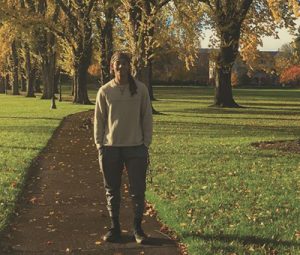 Robert Rose is a senior studying renewable materials. He landed at Oregon State after growing up in New Mexico, a stint in the Air Force and working in Japan as a Department of Defense contractor.
Robert Rose is a senior studying renewable materials. He landed at Oregon State after growing up in New Mexico, a stint in the Air Force and working in Japan as a Department of Defense contractor.
With his first bachelor’s degree in electrical engineering, Rose had broad knowledge of the construction industry, but wanted to switch roles.
“A few friends told me about the College of Forestry at Oregon State, which led me to discover the renewable materials program, and it seemed like a good fit,” he says. “I wanted to learn about what renewable materials are and how to apply renewable products to the field of construction.”
The father of three considers school his job right now. He finished his renewable materials coursework and is now focused on business classes for the marketing and management option within the degree program.
Rose says one of his favorite areas to study is mass timber. He says his dream job is working with innovative products within the construction industry.
“I’m hoping I can take the knowledge and experience I gained here and translate it into getting plugged back into the workforce,” Rose says.
He says he’s excited about mass timber because of its unexpected construction potential.
“People just don’t really think about wood as a suitable material for large-scale construction projects,” Rose says. “But once you start learning about the properties behind it, it’s really intriguing and interesting. There’s also an aesthetic piece to it that I really like, so overall it makes for an interesting material to work with.”
During summer 2017, Rose completed an internship with Accsys Technologies. He worked with the College of Forestry’s Office of International Programs to travel abroad to the company’s headquarters in The Netherlands for a week where he observed the manufacturing process for Accoya wood products.
Once he returned home, Rose worked with Scott Leavengood, director of the Oregon Wood Innovation Center, to test a variety of modified wood products including acetylated red alder similar to the wood that will be used on the exterior cladding of the new George W. Peavy Forest Science Center building.
“Robert is an exceptional student and employee,” Leavengood says. “His natural curiosity; attention to detail and ability to organize, plan and conduct his work independently are strong assets for any researcher.”
A version of this story appeared in the spring 2019 issue of Focus on Forestry, the alumni magazine of the Oregon State University College of Forestry. Learn more about our undergraduate programs here.

 Senior Vanessa Mckinney is passionate about forestry, natural resources and conservation.
Senior Vanessa Mckinney is passionate about forestry, natural resources and conservation. The Oregon Forest Practices Act (FPA) is up for renewal in 2020. According to the State of Oregon, the FPA “sets standards for all commercial activities involving the establishment, management or harvesting of trees on Oregon’s forestlands.
The Oregon Forest Practices Act (FPA) is up for renewal in 2020. According to the State of Oregon, the FPA “sets standards for all commercial activities involving the establishment, management or harvesting of trees on Oregon’s forestlands. In FY 2017 and 2018, the College of Forestry and the
In FY 2017 and 2018, the College of Forestry and the  After a walk across the United States and an epic 48-hour experience in Grand Canyon National Park,
After a walk across the United States and an epic 48-hour experience in Grand Canyon National Park,  When Bill and Marion Collins moved onto 160 acres near Gold Hill in Jackson County, they had no idea what to do with their land or how to manage it.
When Bill and Marion Collins moved onto 160 acres near Gold Hill in Jackson County, they had no idea what to do with their land or how to manage it.
 This year’s Dean’s Dinner was held on May 14, after the grand opening of the A. A. “Red” Emmerson Advanced Wood Products Laboratory.
This year’s Dean’s Dinner was held on May 14, after the grand opening of the A. A. “Red” Emmerson Advanced Wood Products Laboratory.

